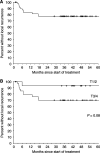Concurrent chemoradiotherapy for squamous cell carcinoma of the anus using a shrinking field radiotherapy technique without a boost
- PMID: 12778060
- PMCID: PMC2741046
- DOI: 10.1038/sj.bjc.6600913
Concurrent chemoradiotherapy for squamous cell carcinoma of the anus using a shrinking field radiotherapy technique without a boost
Abstract
Chemoradiotherapy (CRT) is now widely accepted as the primary treatment modality for squamous cell cancer of the anus. While randomised trials have clearly shown CRT to be more effective than radiotherapy alone, there remains uncertainty over the optimal integration of chemotherapy and radiation. We describe a series of 50 patients treated by a site specialist gastrointestinal nonsurgical oncologist with CRT at a single UK centre. Chemotherapy comprised mitomycin C (MMC) (day 1) and 5-fluorouracil (5-FU) (days 1-4, and 29-32), concurrent with 50 Gy in 25 fractions radiation, using a two-phase shrinking field technique. A radiation boost was not planned. At a median follow-up of 48 months, 11 (22%) of the patients have failed locally, of which three have been surgically salvaged. Nine (18%) have died of anal cancer. These results are comparable with those from large randomised studies, and suggest that a two-phase shrinking field radiotherapy technique with no boost, concurrent with MMC/5-FU chemotherapy, is an effective regimen for this disease. The CRT regimen described here provides the basis for the 'control arm' of the current UK-randomised CRT trial in anal cancer (ACT2).
Figures




Similar articles
-
Three cytotoxic drugs combined with pelvic radiation and as maintenance chemotherapy for patients with squamous cell carcinoma of the anus (SCCA): long-term follow-up of a phase II pilot study using 5-fluorouracil, mitomycin C and cisplatin.Radiother Oncol. 2012 Aug;104(2):155-60. doi: 10.1016/j.radonc.2012.06.006. Epub 2012 Aug 1. Radiother Oncol. 2012. PMID: 22857859 Clinical Trial.
-
Pilot study of FMC (5-fluorouracil, mitomycin C, and cisplatin) with radiotherapy for patients with anal cancer.Cancer Chemother Pharmacol. 2016 Dec;78(6):1263-1267. doi: 10.1007/s00280-016-3185-5. Epub 2016 Nov 9. Cancer Chemother Pharmacol. 2016. PMID: 27830320
-
Toxicity, Tolerability, and Compliance of Concurrent Capecitabine or 5-Fluorouracil in Radical Management of Anal Cancer With Single-dose Mitomycin-C and Intensity Modulated Radiation Therapy: Evaluation of a National Cohort.Int J Radiat Oncol Biol Phys. 2018 Aug 1;101(5):1202-1211. doi: 10.1016/j.ijrobp.2018.04.033. Epub 2018 Apr 19. Int J Radiat Oncol Biol Phys. 2018. PMID: 29859793
-
Combined-modality treatment for anal cancer: current strategies and future directions.Strahlenther Onkol. 2010 Jul;186(7):361-6. doi: 10.1007/s00066-010-2162-x. Epub 2010 Jun 24. Strahlenther Onkol. 2010. PMID: 20582392 Review.
-
Anal carcinoma therapy: can we improve on 5-fluorouracil/mitomycin/radiotherapy?J Natl Compr Canc Netw. 2010 Jan;8(1):135-44. doi: 10.6004/jnccn.2010.0009. J Natl Compr Canc Netw. 2010. PMID: 20064295 Review.
Cited by
-
Effective treatment of anal cancer in the elderly with low-dose chemoradiotherapy.Br J Cancer. 2005 Apr 11;92(7):1221-5. doi: 10.1038/sj.bjc.6602486. Br J Cancer. 2005. PMID: 15798772 Free PMC article. Clinical Trial.
References
-
- Anonymous (1996) Epidermoid anal cancer: results from the UKCCCR randomised trial of radiotherapy alone versus radiotherapy, 5-fluorouracil, and mitomycin. UKCCCR Anal Cancer Trial Working Party. UK Co-ordinating Committee on Cancer Research. Lancet 348: 1049–1054 - PubMed
-
- Bartelink H, Roelofsen F, Eschwege F, Rougier P, Bosset JF, Gonzalez DG, Peiffert D, van Glabbeke M, Pierart M (1997) Concomitant radiotherapy and chemotherapy is superior to radiotherapy alone in the treatment of locally advanced anal cancer: results of a phase III randomized trial of the European Organization for Research and Treatment of Cancer Radiotherapy and Gastrointestinal Cooperative Groups. J Clin Oncol 15: 2040–2049 - PubMed
-
- Chantler C, Garnett ES, Parsons V, Veall N (1969) Glomerular filtration rate measurement in man by the single injection methods using 51Cr-EDTA. Clin Sci 37: 169–180 - PubMed
-
- Cockcroft DW, Gault MH (1976) Prediction of creatinine clearance from serum creatinine. Nephron 16: 31–41 - PubMed
MeSH terms
Substances
LinkOut - more resources
Full Text Sources
Medical
Research Materials

